The direction of the Vancouver Canucks over the past few years has been ambiguous and at times extremely frustrating for fans. It became apparent a few seasons ago that the management team in Vancouver would not fully commit to a rebuild and would instead opt to retool on the fly. However, I have to be honest – the 2019-20 Canucks squad is a cloak-and-dagger threat to win it all.
After a trip to the Stanley Cup Final in 2011, the Canucks began a slow decline, earning a seat in the basement of the NHL standings as a perennial bottom-five team in the league.
The beloved Sedin twins were still productive but would have been better suited to a second or third-line role with reduced minutes. While their puck skills never seemed to regress, their speed did, and it negatively impacted the team’s potency as an offensive powerhouse.
While fans still enjoyed some spectacular plays from the Sedins, Boeser and eventually Elias Pettersson, the Canucks’ front office stagnated the competitiveness of the team by reluctantly pressing onward rather than reassessing the team when things began to sour.
A Reassuring Start for Benning
In May of 2014, then-President of Hockey Operations Trevor Linden announced the hiring of Jim Benning as the Canucks’ new general manager. Under the new leadership of Benning — often referred to by fans on Twitter as just ‘JB’ or ‘Jimbo’ — there was renewed hope for the first time in a while. He served as assistant general manager to former Boston Bruins GM Peter Chiarelli and won the Stanley Cup with them in 2011 — against the Canucks.
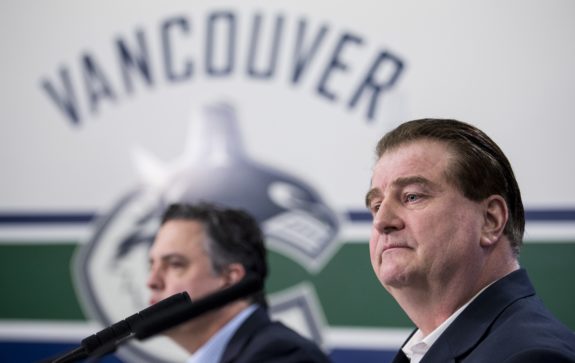
In Benning’s first season as general manager, the Canucks made the playoffs with a 48-29-5 record before suffering a first-round defeat at the hands of the Calgary Flames. The series lasted six games and saw a few Canucks hit milestones such as a first NHL playoff game or first NHL playoff point. Among those who reached both milestones was Canucks’ 2013 first-round draft pick Bo Horvat.
Blazing Improvements for Horvat
Despite the team’s post-season lasting just six games, the series meant a lot to young players like Horvat. That first taste of playoff action served as motivation for him, and in his second season with the Canucks he doubled his assist total from the previous season, going from 12 helpers in 2014-15 to 24 in 2015-16. He also tallied 16 goals in the latter of those two seasons, eclipsing the 13 he scored as a rookie.
Despite seeing year-over-year improvements in every facet of his already impressive game, Horvat has flown under the radar as one of the league’s best two-way centres, chipping in with 61 points in 2018-19 — good for second-best on the team behind Swedish rookie sensation Elias Pettersson.
Horvat took more faceoffs than any other centre in the league with 2,018 draws. No other player in the NHL took more than 2,000 faceoffs. Not only did he step into the faceoff circle more than anyone else, he won 53.7% of the time. The former London Knight ranked ahead of stars like Steven Stamkos, Joe Pavelski, Leon Draisaitl and Auston Matthews.
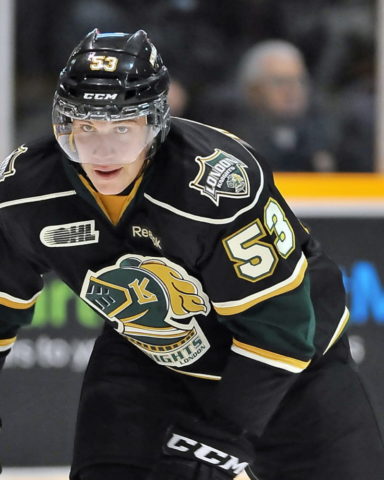
Horvat’s growth over the past few seasons has been extremely encouraging for fans. Not only has he cemented himself as a dynamic offensive player, he also silenced the doubters who were upset when former Canucks’ GM Mike Gillis traded budding star goaltender Cory Schneider for the ninth-overall pick in the 2013 NHL Entry Draft — the pick used to select Horvat.
That trade turned out to be lopsided — in favour of the Canucks — as Schneider has seen a bit of a decline in his save percentage (SV%) and goals-against average (GAA) since joining the New Jersey Devils for the 2014-15 season.
A New Hope
Quinn Hughes isn’t going to blow up the Death Star and save the Galaxy from Darth Vader, but he is going to be instrumental in the re-shaping of the Canucks blue line this season. Having played just five games at the tail-end of the 2018-19 season, we’ve only got a very small sample size of the Canucks’ 2018 first-round pick, but boy did we all love it.
Hughes was selected by the Canucks in the 2018 NHL Entry Draft with the seventh-overall pick after the Red Wings selected Filip Zadina at No. 6. In the five games he played with the Canucks, he tallied three assists. The NHL Network has Hughes pegged for 45 points in his first full NHL season in 2019-20.
His play was much more impressive than his few points suggested, though, as he seamlessly carried the puck from the defensive zone through centre ice roughly two-dozen times in just five contests — more than any other Canucks’ defenseman.
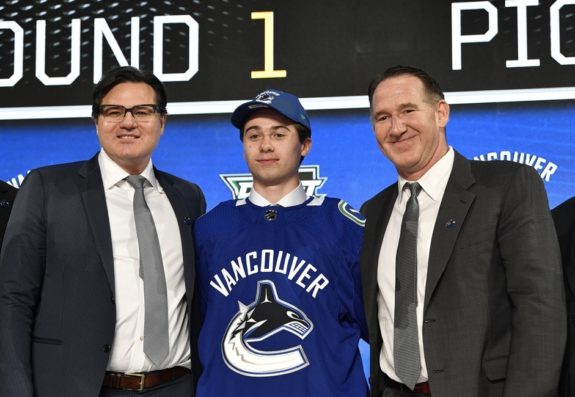
Hughes has the potential to be the most dynamic defender in team history. He boasts some of the smoothest skating in the league — easily weaving his way around opposing players and creating scoring chances for himself and his teammates.
Hughes has excellent offensive awareness and has strong puck skills. His excellent vision saw him rewarded with some 3-on-3 overtime minutes alongside stars like Pettersson and Brock Boeser.
The three were virtually untouchable together and Canucks nation collectively screamed like children on Christmas morning whenever the trio hit the ice.
Hughes’ offensive prowess was the missing piece for the Canucks’ power play, which ranked 21st out of 31 teams with a 17.1 percent success rate during the 2018-19 season. In his fourth game with the Canucks he notched two assists against Nashville, with both coming on the man advantage.
His elusiveness and elite passing ability allowed him to set up Markus Granlund for a pretty goal with one second left on the power play at the 11:11 mark of the first period. It is worth noting that one of the defensemen Hughes overcame along the boards was former Norris Trophy winner P.K. Subban.
If Hughes can build on the success he found at the end of last season, the Canucks should have one of the most potent power play squads in the whole league. If Boeser and Pettersson can stay healthy, the trio will victimize opposing goaltenders for 82 games.
‘Boes’ Case Scenario
Canucks’ sniper Brock Boeser has scored 59 times in 140 career games. Fans know, however, that his goals total would be higher if he could have remained healthy over the past two seasons. Since joining the Canucks full-time in the 2016-17 season, He has missed a total of 33 games due to injury.
He was one of the top contenders for the Calder trophy in 2017-18 before succumbing to a season-ending injury against the New York Islanders in March of 2018.
Ironically, the Islanders had the eventual Calder Trophy winner Mathew Barzal in their lineup when Boeser’s season came to an end. He was likely Barzal’s only competition for the award given to the league’s best rookie.
Despite a shortened first season, Boeser scored 29 goals and likely would have crushed Pavel Bure’s rookie record of 34 goals and 60 points had he not been injured. Boeser finished the year with 55 points in 62 games — a great first season.
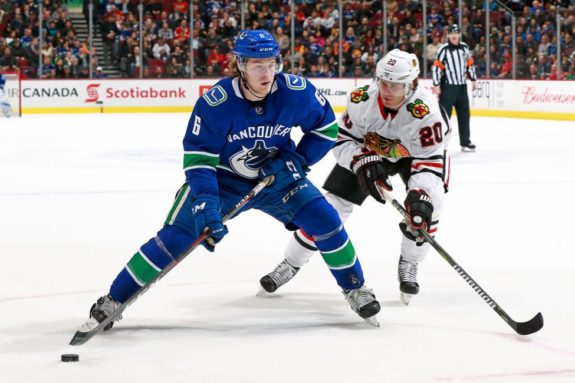
In Boeser’s second full season with the Canucks, he played 69 games — seven more than the previous season. He saw a very slight dip in production, potting one extra point but playing in half a dozen extra games.
His ‘sophomore slump’ was nothing to worry about as he still scored a respectable 26 goals and asserted himself as a top-line winger alongside Calder-winning center Pettersson.
If Boeser can remain healthy and replicate his previous successes, he should be counted on for 35 goals and 30 assists. As part of the first line with Elias Pettersson and either of newly acquired forwards J.T. Miller or Michael Ferland, fans can expect a whole new kind of offensive potency from their young guns.
With a tougher, grittier player like either of the aforementioned Ferland or Miller, the idea is that Vancouver’s dynamic duo will have more confidence and freedom to execute highly skilled plays in the offensive zone. With an established physical force like Ferland watching their backs, opposing teams will think twice about taking a run at players like ‘Petey’ and ‘Boes’.
Final Puzzle Piece
The Canucks organization has seen a revolving door of goaltenders over the past few seasons — really since Roberto Luongo was traded to the Florida Panthers in 2014.
As far as goalies are concerned, the fans in Vancouver have cheered for Ryan Miller, Eddie Lack, Roberto Luongo, Cory Schneider, Thatcher Demko and Jacob Markström over the past few seasons. With Demko and Markström the two bonafide NHL goaltenders remaining in 2019, it is unclear just how potent of a tandem they can be for the Canucks.
Markström — who came over from Florida in the Luongo trade a handful of years ago — put up ridiculous numbers between Dec. 6 and Jan. 4 of the 2018-19 season, boasting a 9-2 record along with a .938 SV% and 1.82 GAA.
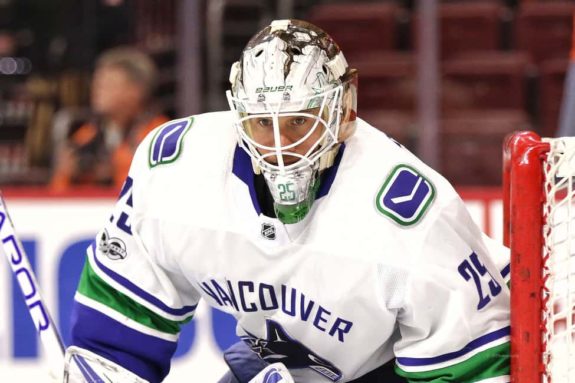
Despite the team’s woes and overall lack of success, Markström’s .912 SV% last season was solid for a team battling for a playoff birth for the first time since 2014-15. If the team hopes to make a splash come October, they’ll need their starting goalie and Demko to be dependable throughout the year.
Inconsistency simply will not do the team justice, and another bottom-five finish will seriously jeopardize Benning’s future as GM. Markström needs to find another gear and elevate his game. Every Cup-contending team needs an All-Star netminder and I believe he can be just that.
With a better defence in front of him, the 6-foot-6 Swede should flourish and stop a lot more pucks in the upcoming season. With Hughes, Tyler Myers, Alex Edler and Chris Tanev all healthy, things should be a lot easier on the goaltending front.
All in all, the 2019-20 Canucks are ready to battle for a playoff spot behind the leadership of guys like Pettersson and Horvat. There is a very good chance we see the boys in blue back in the postseason in 2020.